The Friendly Fire Room Presents
Listen And See
Thank you Wanda Barlow for this great idea!
Pronouns Metaphors Errors Part 23
Pronouns Metaphors Erros Pt 23
To God be the Glory, great things He has done.
mcmtffr.org wishes to acknowledge and thank Derek Konofalski and Rocket Media for making this page:
Mobile Friendly
Message
April 19, 2015
Part 23
The rule of thumb:
Whenever and wherever it is possible, the words of Scripture are to be understood literally.
The rule of thumb (cont.):
But, when a statement appears to be,
contrary to our experience,
contrary to known fact,
contrary to revealed truth,
or seems to be at variance with the general teaching of the Scriptures;
then we may reasonably expect that some Figure of Speech is being used, to call our attention and prompt us to discover the truth that is emphasized.
Is this a metaphor, or not?
I am the daughter of Bethuel.
![]() I am the bread which came down from heaven.
I am the bread which came down from heaven.
![]() I am a worm, and no man.
I am a worm, and no man. ![]()
![]() I am your son. (I am the son of you.)
I am your son. (I am the son of you.)
I am the light of the world.
![]() I am the door of the sheep.
I am the door of the sheep.
![]() I am the good shepherd.
I am the good shepherd.
![]() I am the vine, you are the branches.
I am the vine, you are the branches.
I am the way, the truth, and the life.
![]() I am the true vine, and cMy Father is the vinedresser.
I am the true vine, and cMy Father is the vinedresser.
![]() I am Abraham's servant.
I am Abraham's servant.
Let’s think about developing a practical method for dealing with words of Scripture which are possibly metaphors, so that we might understand the original meaning God intended for His Word.
It is especially important to have a way to discover facts which definitively confirm or deny whether a metaphor is being used, in order to avoid the mistake of translating a “metaphor element” as a “literal element”.
Otherwise the original purpose of using a metaphor, to compare two ideas, could become blurred, and an unintended “literal element” be made from an actual “metaphorical element”.
This is one of the sources of false doctrines… some of which have been perpetuated for centuries!
I think word-change figures are usually easier to evaluate than are metaphors.
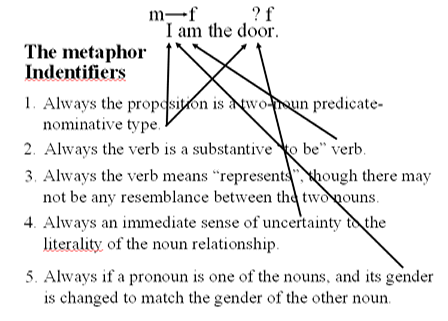
Here is a serial list of statements from Matthew which are well-known metaphors, for practice.
He who sows the good seed is the Son of Man.
The field is the world.
The good seed are the children of the kingdom.
The tares are the children of the wicked one.
The enemy who sowed them is the devil.
The harvest is the end of the age.
The reapers are the angels.
1. Always the proposition is a two-noun predicate-nominative type.
He who sows the good seed is the Son of Man.
The field is the world.
The good seed are the children of the kingdom.
The tares are the children of the wicked one.
The enemy who sowed them is the devil.
The harvest is the end of the age.
The reapers are the angels.
NKJ John 4:24 God is Spirit,
![]() not a metaphor
not a metaphor
2. Always the verb is a substantive “to be” verb.
Note: The verb will not be in italics in your NT translation.
He who sows the good seed is the Son of Man.
The field is the world.
The good seed are the children of the kingdom.
The tares are the children of the wicked one.
The enemy who sowed them is the devil.
The harvest is the end of the age.
The reapers are the angels.
3. Always the verb means “represents”, though there may not be any resemblance between nouns.
He who sows the good seed is (represents) the Son of Man.
The field is (represents) the world.
The good seed are (represents) the children of the kingdom.
The tares are (represents) the children of the wicked one.
The enemy who sowed them is (represents) the devil.
The harvest is (represents) the end of the age.
The reapers are (represents) the angels.
Note: The use of “represents” explains much!
4. Always an immediate sense of uncertainty as to the literality of the noun relationship.
He who sows the good seed is the Son of Man.
The field is the world.
The good seed are the children of the kingdom.
The tares are the children of the wicked one.
The enemy who sowed them is the devil.
The harvest is the end of the age.
The reapers are the angels.
5. Always if a pronoun is one of the nouns,
and its gender is changed to match the gender of the other noun.
He who sows the good seed is the Son of Man.
The field is the world.
The good seed are the children of the kingdom.
The tares are the children of the wicked one.
The enemy who sowed them is the devil.
The harvest is the end of the age.
The reapers are the angels.
Wait for it.....
1. Always the proposition is a two-noun predicate- nominative type.
2. Always the verb is a substantive “to be” verb.
3. Always the verb means “represents”, though there may not be any resemblance between nouns.
4. Always an immediate sense of uncertainty to the literality of the noun relationship.
5. Always if a pronoun is one of the nouns, and its gender is changed to match the gender of the other noun.
Summary Card
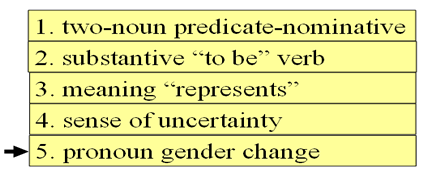
Let’s take a closer look to discover this one…
NKJ Matthew 13:38
![]() The field is the world,
The field is the world,
the good seeds are the sons of the kingdom,
but the tares are the sons of the wicked one.
![]()
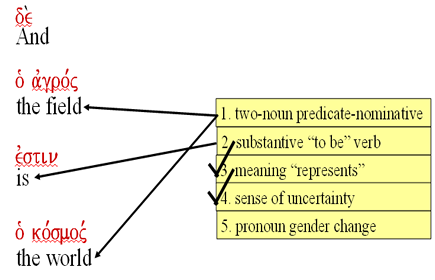
Just some extra information…
![]()
And
![]() masculine gender, def. article
masculine gender, def. article
the field
![]() convertible statement
convertible statement
is
![]() masculine gender, def. article
masculine gender, def. article
the world
NKJ Matthew 13:38
The field is the world,
![]() the good seeds are the sons of the kingdom,
the good seeds are the sons of the kingdom,
but the tares are the sons of the wicked one.
![]()
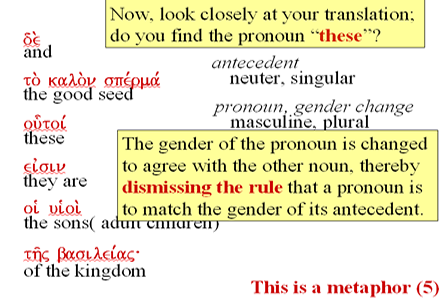
NKJ Matthew 13:38
The field is the world,
the good seeds are the sons of the kingdom,
![]() but the tares are the sons of the wicked one.
but the tares are the sons of the wicked one.
![]()
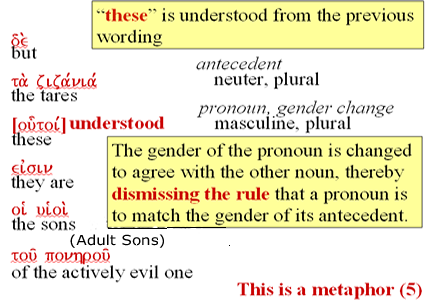
NKJ Matthew 26:26
![]() And as they were eating, Jesus took bread,
And as they were eating, Jesus took bread,
blessed and broke it, and gave it to the disciples
and said, “Take, eat; this is My body.”
![]()
![]()
Then
![]()
during the eating time of them
![]()
took hold of
![]()
Jesus
![]() masculine, singular
masculine, singular
a loaf of bread
NKJ Matthew 26:26
And as they were eating, Jesus took bread,
blessed and broke it, and gave it to the disciples
![]() and said, “Take, eat; this is My body.”
and said, “Take, eat; this is My body.”
![]()
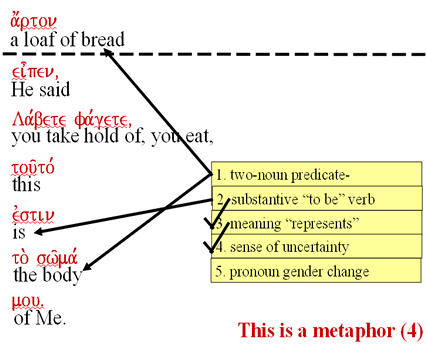
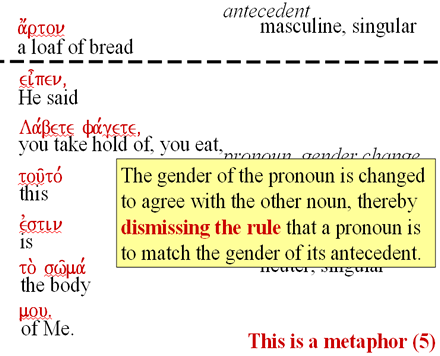
Rome has insisted on the literal or the figurative sense of words of Scripture just as it suits her own purpose, and not at all according to the laws and the true science of language.
The record of history tells us that Martin Luther himself was mislead, through his ignorance of this simple law of figurative language.
Martin Luther held the idea of consubstantiation, which teaches the bread remains bread and the wine remains wine, but by faith they are the same as Jesus’ actual body.
Luther did not believe in the Roman Catholic doctrine of transubstantiation, but he did not go far enough away from it.
John Calvin taught that Jesus’ presence in the bread and wine was real; but only spiritual, not physical.
Zwingli taught that the bread and wine are symbols that represent the body and blood of Jesus.
Actually, a symbol is a most advanced and sophisticated form of representation.
When the Swiss Reformers debated the issue with Martin Luther at Marburg, there was a huge contention.
Luther insisted on some kind of physical presence because Jesus said this is My body.
He insisted over and over again, writing it on the velvet of the table, Hoc est corpus meum –"this is My body" in Latin.
Zwingli replied, “Jesus also said ‘I am the vine’, and ‘I am the door’, but we understand what He was saying.”
Luther was so strong on this because he saw it as an issue of believing Christ’s words, and because he thought Zwingli was compromising, Luther said Zwingli was of another spirit (andere geist).
Ironically, later, Luther later read Calvin’s writings on the Lord’s Supper (which were essentially the same as Zwingli’s) and seemed to agree with Calvin’s views.
Meyer's NT Commentary
“There can be no doubt that ![]() this is the subject, and can only refer to the bread that was being handed to them, and not to the
living body of Christ,…”
this is the subject, and can only refer to the bread that was being handed to them, and not to the
living body of Christ,…”
In Luther’s controversy with Zwingle,
he persisted in holding to a literal sense
of the metaphor, and by doing so, he forced it
to have a meaning which it never has.
Luther led all of Germany into this error.
True, he rejected full “transubstantiation,” yet he fell into another invention of “consubstantiation”, and the Lutheran Church has it to this day.
If we look at the Scriptures carefully, we will find a pair of metaphors; one referring to “bread” and the other refers to “the cup,” but it has never been claimed that “the cup is changed into “blood.” While, in fact, the word “cup’ is used as a name-change( metonymy) for the word “blood”, if one takes the word “bread” literally, they are forced to take the word “cup” literally as well. The Church at Rome can do whatever she wants with the Scriptures, because that Church is above the Scriptures in authority, therefore the Word of God is pliable in her hands; she twists it to conform to her will.
Many will be surprised on the Day of Judgment when they discover that it was just as the Word of God says; only the righteousness of Christ is able to save you.All men are sinners and no one can save himself. God is just, so He must punish sin; but He is also merciful, moreover gracious, and offers His Son as the perfect sacrifice in order to purchase a place for you in heaven, which He offers to you as the free gift of eternal life. A couple of more details from the Greek…
Jesus is the Christ,
Jesus is the Messiah,
Jesus is the Anointed One,
He is God Incarnate, Not a metaphor.
the Good Shepherd!
In order to pay the debt of our sins, He came from Heaven, having been sent by the Father,
where He lived a life of perfect obedience to the Father
even unto the shameful death upon the cross
in order to pay the debt of your sins.This gift must be received by faith,
believing that Jesus’ perfect life and Cross Work
was His complete and necessary Atonement
for your sins, in your behalf.
Faith is a gift that comes by the Power of God the Holy Spirit working in a person’s innermost being.
Only the power of God can open your heart to the willingness to have the void within it filled
with the presence of Christ by His Spirit.The Holy Spirit has the authority and power to quicken your dead spirit, to make it come to life.
Only the life of His Spirit’s quickening of your heart will allow the Gospel message of salvation to even make sense to you, to truly “hear” the message and give you the ability,
as the Holy Spirit bears witness to Jesus,
to recognize your need for forgiveness and restoration, and gain the desire of your heart to be favorably inclined to want to receive Christ as your personal Lord and Savior.If you have not done so before this moment,
ask Jesus to forgive you your sins,
tell Him you’ve stop trying to be your own savior,
and ask Him to come into your life right now,
and to give you eternal life. Then, in faith believing,
thank Him for the gift that He is giving you,
the one He paid for in full in your place,
in Jesus’ name,
AMEN
Copyright April, 2015
Rev. Jim Craig
All Rights Reserved
Bibliography
Agnes, Michael and Charlton Laird (eds.). Webster’s New World Dictionary and Thesaurus. New York, NY: Macmillan, 1996.
Aland, Kurt, Matthew Black, Carlo M. Martini, Bruce M. Metzger, and Allen Wikgren (eds.). The Greek New Testament, 4th rev. ed. Germany: Biblica-Druck, 1994.
Benner, Jeff A. The Ancient Hebrew Lexicon of the Bible. College Station, Texas: Virtualbookworm.com Publishing Inc., 2005
Bullinger, E. W. Figures of Speech Used in the Bible; Explained an Illustrated. Grand Rapids, Michigan: Baker Book House, 2007.
Chapman, Benjamin. Greek New Testament Insert. Grand Rapids, Michigan: Baker Book House, 1977.
Dana, H. E., and Julius R. Mantey. A Manual of the New Testament. Canada: The Macmillan Company, 1957.
Louw, Johannes P. and Eugene A. Nida. Greek-English Lexicon of the New Testament Based on Semantic Domains. New York, NY: United Bible Societies, 1989.
The ESV Study Bible. Wheaton, Illinois: Crossway, 2011.
Metzger, Bruce M. Lexical Aids for Students of New Testament Greek. Princeton, New Jersey, 1977.
Wikipedia contributors. "Xenophon." Wikipedia, The Free Encyclopedia. Wikipedia, The Free Encyclopedia, 15 Aug. 2014. Web. 19 Aug. 2014.
Wuest, Kenneth S. The New Testament; An Expanded Translation. Grand Rapids, Michigan, 1992.
Wuest, Kenneth S. (Revised, Donald L. Wise). The Practical Use of the Greek New Testament, rev. ed. Chicago, Il: Moody Press, 1982.
Walsh, J. Martyn and Anna Kathleen Walsh. Plain English Handbook: A Complete Guide to Good English, 7th rev. ed. Cincinnati, Ohio: McCormick-Mathers PublishingCompany,1977.